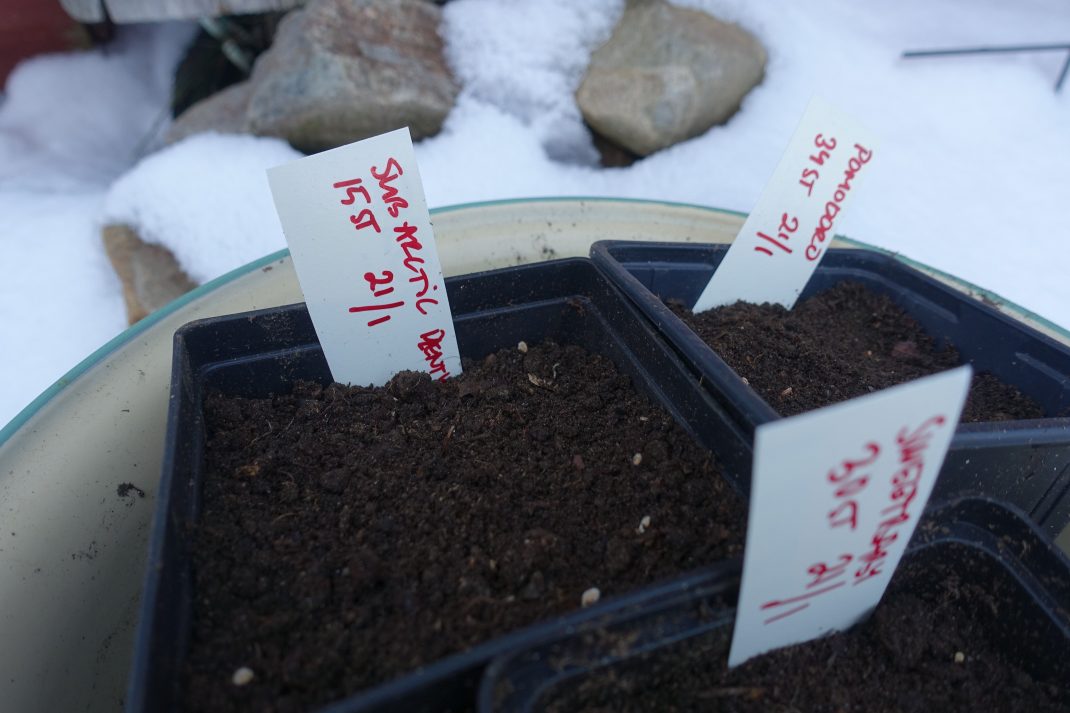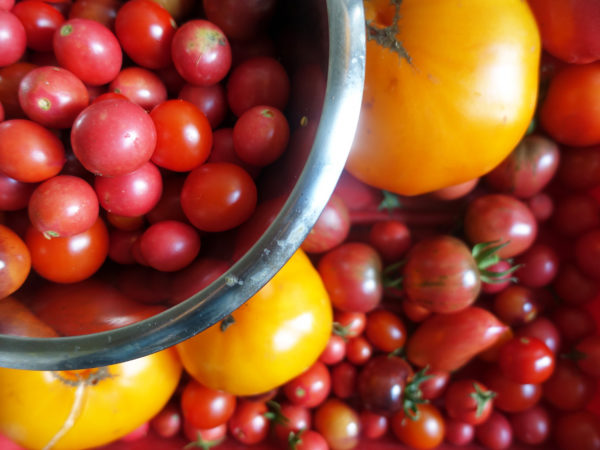11 Tips on Winter Gardening
Part of my winter gardening routine is to sow new seeds. Sounds strange? Well, there are a few things you need to think about to succeed. Read my 11 best tips here!

I took this picture in late winter 2020 when I decided to do some winter gardening. I sowed my seeds in troughs and containers in my polytunnel.
I'm in the middle of preparing my beds, troughs and pots for new sowings. Yes, even now! Those of you who follow me know how strongly I feel about winter gardening. Maybe it's a good choice for you and your garden too?
I usually winter sow seeds in a quarter of my growing spaces. I do it in the beds outside, in my polytunnels and greenhouse, raised beds and pots. And in all kinds of little troughs, boxes and containers too of course.
Have you tried winter gardening too? Today, I wanted to share a few tips on how you can make the most of your winter sowings. If this subject is completely new to you, then I recommend checking out the link below instead. You can read everything you need to know about getting started here:
Read more: Winter sowing for beginners

This is a ragged jack kale variety that I broadcast sowed in a large pot in winter. The leaves are so pretty, and delicious too!
Broadcast sowing
Do you usually sow your seeds one by one? Try broadcast sowing instead! This is definitely the way to go if you want to perfect your winter gardening. Just scatter a handful of seeds in your rows, close together. It's the perfect way to ensure that you get at least a few good plants in the end. Some are going to freeze or become slug food of course. But not all of them!
Go for microgreens
The earliest harvest is always small. Remember that when you sow. You can grow microgreens in comparably crowded rows, close together. This goes for any kind of sowing. So, it doesn't matter if you do winter gardening in a greenhouse, your beds outside, pots or raised beds. You might even be able to skip the rows completely and just scatter the seeds in an entire frame if you want to. We harvest the microgreens quickly and then you can just go ahead and use the space for other projects.
Make rows
If you grow in a spot with self-seeding weeds, it's better to do it in rows. This makes it a lot easier to see what you want to keep in the bed and what you want to remove. Something that's especially beneficial if you're new to winter gardening too. But a good reminder to the rest of us of course. Rows make everything easier.

Winter gardening is the best! I sowed several different vegetables here. For example leafy greens, radishes and carrots in mid-February 2020. It's easy to weeding in the rows, even if the plants are still small.
The Same Vegetable in Several Spots
When you do winter gardening, a main thing to think about is to spread your risks and sow your favorite vegetables in multiple spots. You might not think about the fact that the areas can be very different, even inside the same greenhouse. So be creative and put your vegetables in several spots!
Sow several times
That's why you should also try to do multiple sowings at different times. The late sowings might do better than the early ones. Or vice versa. If you put all your eggs in one basket (all the seeds in the same spot at the same time), you risk losing the entire crop.
Read more: 6 vegetables I winter sow
Slow or fast-growing?
Planning is key! Especially considering what you want to do with the area later. Some of the winter sowings can be a bit trickier, simply because they need to stay in the ground for such a long time. For example carrots, parsnips and salsify. That's why I try to divide the spaces and put the fast-growing vegetables in one spot, and the others that need a little more time in another. This makes things a lot easier later in the season.

Early leafy greens and carrots. I decided to winter sow the carrots in my greenhouse. The beans in the picture were cultivated in the greenhouse too. I did the sowing indoors in March and planted it in the polytunnel in April.
Sacrifice old seeds
I'm a bit of a seed hoarder, and I sometimes need to clean out my stocks. Do you have the same problem? Why not make a little seed mix with your leftover lettuce, cabbage and leafy green seeds. The seed viability of older seeds isn't as good. Well, at least not if you take some short cuts with the seed storage. But you won't even notice this when you mix the seeds and broadcast sow them.
More: Winter Gardening with Monty Don
Starting seeds and transplanting later
Winter gardening is not only about sowing seeds outside and harvesting the vegetables in the same spot later. You can also start seeds indoors and then transplant the seedlings to the beds in the garden later. This method also works really great for lettuce, scallions and plenty of summer flowers.

I'm growing Cegolaine close together with black kale that I harvest leaf by leaf. The lettuce was overwintered in my polytunnel and I sowed the black kale right in this spot. I can transplant these vegetables to the beds outside later.
Avoid tomatoes
A lot of people talk about winter sowing tomatoes. Which is fun and exciting to try of course. But I really wouldn't recommend doing it if you bought a particular variety that you're really looking forward to growing. Small tomato plants are sensitive to frost and big temperature changes. It's especially difficult in climates where the temperature can drop unexpectedly. For example, it's not so uncommon for us here in zone 3 to suddenly get a night of frost in the beginning of May. The seeds will germinate a lot later in a colder climate and surprisingly do better too. But of course, you have to wait a bit longer for the harvest.

I sometimes experiment with winter sowing tomatoes in pots, plug trays, troughs and the beds in my greenhouse and outside. It just hasn't been producing the results I was looking for.
Don't water before a cold spell
If you sow your seeds in a wet spot, then you might risk getting the seeds destroyed in winter. This can happen if the temperature fluctuates a lot. If you winter sow in a greenhouse for example, it's probably best to hold off the watering if you know that a cold spell is coming. Just let the seeds rest in the soil and only start watering when you think it's time to "wake them up". You can of course water before sowing if the weather is mild, if (and only if) you think that the soil has time to absorb the water properly. We don't want to have water laying around in little pockets of air in the soil around the seeds.
Delay germination
Avoid covering your sowings with row cover, lids or plastic too soon. We don't want to do it before we know that the seedlings are going to be alright. Plenty of vegetables germinate early, but they might be too small and weak to survive a sudden cold spell very early. Why not wait a while before you cover them. I usually wait until February or similar here in southern Sweden (zone 3) before I cover my new seeds.

Spinach is one of my favorite winter vegetables. I'm going to write a bit more about growing it in winter soon.
I feel like I could go on about winter gardening forever. If you decide to sow seeds in winter, then you need to remember that some things might not go according to plan. I usually do a bunch of these winter sowings so that I'm all set in case some of them don't go so well.
Good luck with your winter gardening!
/Sara Bäckmo
24. January 2021



Leave a Reply
You must be logged in to post a comment.